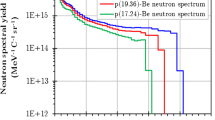Abstract
A method is described for the simultaneous determination of oxygen and fluorine; the latter has a lower neutron-activation threshold energy so that the fluorine-to-oxygen16N formation ratio changes after partial moderation of the incident 14.7 MeV neutron beam. In mixtures containing approximately equal amounts of fluorine and oxygen, these elements can each be determined with a precision of ca. ±1%; as expected, errors in the determination of a minor component (ca. 17%) are larger, being ca. ±5%.
Similar content being viewed by others
References
G. OLDHAM, K. G. DARRALL, Intern. J. Appl. Radiation Isotopes, 20 (1969) 29.
C. M. LEDERER, J. M. HOLLANDER, I. PERLMAN, Table of Isotopes, 6th ed., Wiley, New York, 1968.
P. JESSEN, M. BORMANN, F. DREYER, H. NEUERT, Nucl. Data, 1 (1966) 103.
Author information
Authors and Affiliations
Rights and permissions
About this article
Cite this article
Bibby, D.M., Guinn, V.P. The use of threshold energy differences in fast neutron activation analysis for oxygen and fluorine. J. Radioanal. Chem. 29, 121–127 (1976). https://doi.org/10.1007/BF02516896
Received:
Issue Date:
DOI: https://doi.org/10.1007/BF02516896




